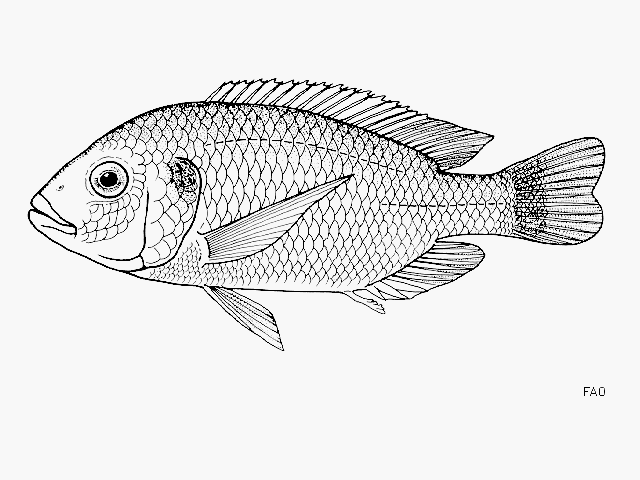| Cichlidae (Cichlids), subfamily: Pseudocrenilabrinae |
| 36 cm SL (male/unsexed) |
|
benthopelagic; freshwater, |
| Africa: Lake Malawi and its catchment (Ref. 118630), including crater lakes Kingiri, Ilamba and Massoko (Ref. 118638) and Upper Shire River (Ref. 37112). |
|
Dorsal spines (total): 16-17; Dorsal soft rays (total): 10-11; Anal spines: 3-3; Anal soft rays: 8-10. Diagnosis: A heavily-built large tilapia species with a wide rounded head; dwarf populations exist in some crater lakes, showing bony 'hunger-form' body shape (Ref. 118638). Females and juveniles with grey bodies and 6 or more vertical bars; males have a bright blue, occasionally white or green, 'mask' across the head; when fully ripe, the underside of most of the body can be black, with the upper surface a conspicuous white to pale blue; genital tassel can be long and branched, pinkish to bright yellow; females and non-territorial males are indistinguishable from Oreochromis karongae (Ref. 118638).
Description: Length of head35.7-38.0% of standard length; lower pharyngeal toothed area with concave sides; median length of bone 1.26-1.36 times its width and 37.6-40.6% length of head; blade 1.6-2.4 times the median length of the toothed area; length of lower jaw 31.4-34.0% length of head; teeth of jaws in 3-5 rows (Ref. 2).
Colouration: Breeding male silvery blue with white and pale blue top of head and dorsum and white dorsal margin (Ref. 2). |
| A semi-pelagic species (Ref. 4967), found in all kinds of habitats but seen mostly in shallow water; it is abundant in the southeastern arm of Lake Malawi, where it occurs in shallow, vegetated bays (Ref. 5595). It feeds on phytoplankton and sometimes from the sediment on the sand; diatoms constitute the major part of its diet (Ref. 5595). Major component of the fisheries catch in Lake Malawi (Ref. 118638). IUCN conservation status is endangered, due to declining population trend (Ref. 118638). |
|
Critically Endangered (CR); Date assessed: 22 May 2018 (A2d) Ref. (130435)
|
| harmless |
Source and more info: www.fishbase.org. For personal, classroom, and other internal use only. Not for publication.

